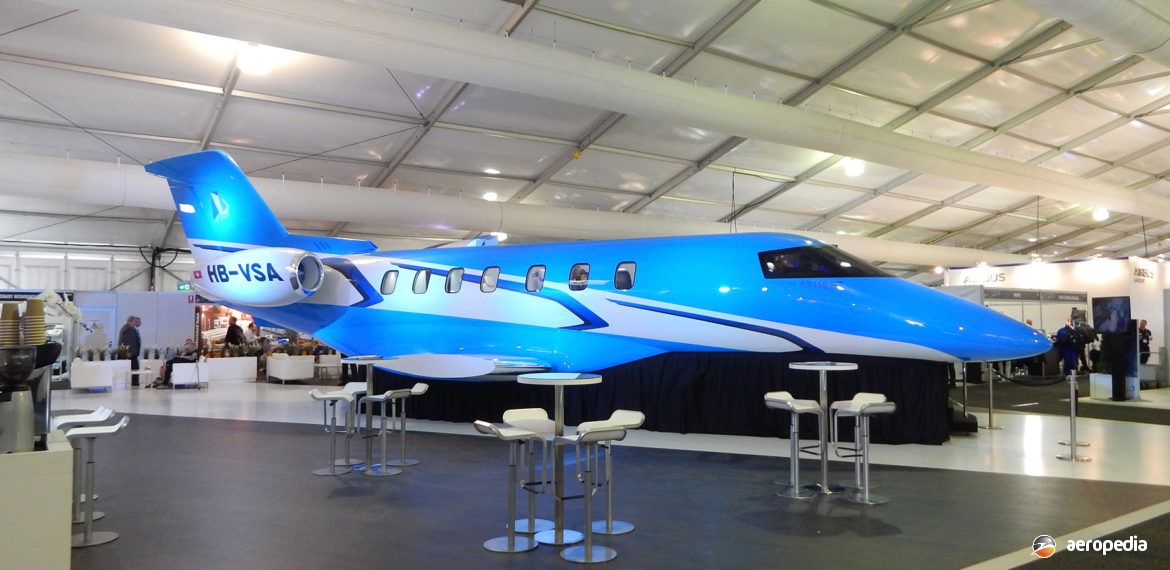Photograph:
Pilatus PC-24 mockup HB-VSA at Avalon, VIC in February 2015 (David C Eyre)
Country of origin:
Switzerland
Description:
Twin-engine business and executive turbofan powered monoplane
Power Plant:
Two 3,400 lbst Williams FJ44-4A turbofan engines
Specifications:
- Wingspan: 17.0 m (55 ft 9 in)
- Length: 16.82 m (55 ft 2 in)
- Height: 5.3 m (17 ft 4 in)
- Wing area: 30.91 m² (332.6 sq ft)
- Max speed: 787 km/h (489 mph)
- Stalling speed: 150 km/h (93 mph)
- Service ceiling: 13,716 m (45,000 ft)
- Single-engine ceiling: 7,925 m (26,000 ft)
- Range: 3,610 km (2,243 miles)
- Fuel capacity: 3,363 litres (740 Imp gals)
- Take-off distance: 820 m (2,690 ft)
- Rate of climb: 1,337 m/min (4,075 ft/min)
- Landing distance over 15 m (50 ft) obstacle: 770 m (2,525 ft)
- Range with max payload: 2,200 km (1,367 miles)
- Max certified altitude: 13,716 m (45,000 ft)
- Max altitude with single-engine operation: 7,925 m (26,000 ft)
- Empty weight: 4,967 kg (10,950 lb)
- Max payload: 2,500 kg (5,511 lb)
- Max payload with full fuel: 415 kg (915 lb)
- Loaded weight: 8,006 kg (17,650 lb)
History:
Pilatus Aircraft Ltd was founded in 1939 and since then has operated from Stans, Switzerland. It has been the only Swiss company to develop, produce and sell aircraft to customers around the world, ranging from military trainers to now, a business and executive jet. It has some 1,600 employees and has branches at Altenrhein in Switzerland, Broomfield in Colorado in the United States, and Adelaide, SA in Australia.
The PC-24 is a twin-engine business and executive jet aircraft developed by Pilatus Aircraft in Switzerland for the world market. It immediately became popular. The aircraft is a development of the PC-XII. Much information or feedback was used from operators of the PC-XII aimed at the PC-24 being able to operate from fields used by the PC-XII, in particular the ability to use short runways. The design was first shown to the public at the European Business Aviation Convention & Exhibition in Geneva on 21 May 2013, was expected to make its first flight in late 2014, and was expected to enter service after certification in 2017. It is able to operate with a range of 3,300 km (2,051 miles) carrying a crew of two and six passengers at a speed of 786 km/h (488 mph). It is equipped with a large cargo door (1.25 m by 1.3 m – 4 ft 1 in by 4 ft 3 in) as standard equipment.
Pilatus announced the aircraft would be operated by a single-pilot and orders would commence to be taken in May 2014. Roll out was scheduled and took place on 1 August 2014, the National Day of Switzerland, the aircraft being towed out of the Company’s facility by a team of 24 horses. Orders were soon taken and by mid June 2014 had reached 84 aircraft with Falcon Aviation Services, Jetfly, PlaneSense, abnd U-haul International; 67 for private owners; and three for the Royal Flying Doctor Service of Australia, Western Division. At the Australian International Airshow at Avalon, VIC in February 2015 Pilatus on its stand demonstrated a full-size fuselage of the PC-24 to show to prospective customers, to the media and to the public attending the show.
The aircraft is fitted with a Pilatus ACE avionics system and is single-pilot certified. The cabin has a continuous flat floor with a capacity of 14.2 m³ (501 cub ft). The baggage compartment is internal and is pressurised. It has an optimised wing with geometry combining short field performance with a competitive cruising speed; and it has a dual main wheel undercarriage for operations from paved and unpaved surfaces. In the executive aircraft role it can carry a crew of two with six or eight passengers.
The prototype (HB-VXA) flew for the first time at Stans on 11 May 2015, being followed by the 2nd prototype (HB-VXB) on 16 November 2015, making a flight of 82 minutes. At this time the prototype had accumulated 143 hours in 87 flights, the certification program taking 2,300 hours, with first deliveries taking place in late 2017. On 7 December 2017 Pilatus received US FAA and European Safety Agency type certificates, the first example for a customer being delivered to PlaneSense in Stans on the following day, flying across to the United States in January 2018.
First production aircraft (HB-VSB – c/n 101) was delivered as N124AF to fractional ownership company, PlaneSense, which had six examples on order. At a ceremony on 7 February 2018 this aircraft was handed over at the Pilatus Business Aircraft Ltd facility at Broomfield, Colorado, PlaneSense having since 1996 operated a fleet of 36 PC-XIIs. Following certifications Pilatus continued with post-certification flight testing with particular emphasis on steep approaches and landings, with operations from unmade runways.
The first aircraft for the RFDS Australia, Western Australian Division, was flown at Stans in June 2018, this aircraft being HB-VSF for test flying before delivery to Australia, where it became VH-VWO (c/n 105 – Rio Tinto Life Flight), being registered on 23 November 2018. The second arrived later in that year, becoming VH-KWO (c/n 106 – ex HB-VSG). At that time Australian orders for the type were three for Western Australia and one for the Adelaide Central Division. A further example became VH-FGM (c/n 119) on 3 December 2018 registered to Dalyoline Pty Ltd of North Perth, WA.

